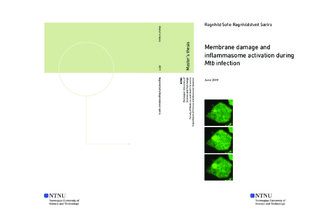| dc.contributor.advisor | Beckwith, Kai Sandvold | |
| dc.contributor.author | Sætra, Ragnhild Sofie Ragnhildstveit | |
| dc.date.accessioned | 2019-10-11T14:00:14Z | |
| dc.date.available | 2019-10-11T14:00:14Z | |
| dc.date.issued | 2019 | |
| dc.identifier.uri | http://hdl.handle.net/11250/2621690 | |
| dc.description.abstract | Tuberkulose, som forårsakes av Mycobacterium tuberculosis (Mtb), er et globalt helseproblem, og økt forståelse av de molekylære mekanismene bak Mtb-infeksjon er viktig. På enkeltcellenivå kan Mtb-infeksjon føre til aktivering av NLRP3-inflammasomet, og skade på plasmamembranen kan være en drivkraft bak dette. Proteinsystemet ESCRT har de siste årene vist seg å være viktig i plasmamembranreparasjon, og kan dermed ha en rolle i dette systemet. I tillegg kan autofagimaskineri rekrutteres til Mtb når bakterien er fri i cytosol. Autofagi kan derfor også påvirke utfallet.
Arbeidet som beskrives i denne masteroppgaven hadde som målsetning å avdekke nye detaljer om det molekylære samspillet mellom fagosomal rømning, autofagi og membranreparasjon under NLRP3-inflammasomaktivering og mykobakteriell infeksjon. Total intern refleksjonfluorescensmikroskopi (TIRF-mikroskopi) på levende THP-1-celler ble benyttet for å undersøke dette. Celler som uttrykte fluorescensmerkede proteiner ble infisert med auxotrofen Mtb mc26206, og deretter studert med TIRF-mikroskopi. Resultatene ble sammenliknet med resultater fra behandling av cellene med nanosilica, som er en kjent NLRP3-trigger via lysosomødeleggelse. Videre ble det fluorescente fargestoffet Calbryte 590 AM brukt til å undersøke rollen til kalsiumflukser.
Resultatene viste at etter bakterien fikk tilgang til cytosol, identifisert ved rekruttering av galectin 3 (gal3), kunne man ofte se rekruttering av det ESCRT-assosierte proteinet ALG2 til plasmamembranen. Omtrent halvparten av ALG2-rekrutteringshendelsene skjedde på samme sted som en gal3-positiv membranlomme. Denne rekrutteringen korrelerte med kalsiumtilstrømning i cytosol. Autofagimaskineri ble i større grad rekruttert til gal3-positive membranlommer som ikke var relatert til plasmamembranrekruttering av ALG2. Autofagi kan altså være en negative regulator av prosessen. Inhibering av autofagi resulterte imidlertid ikke i noen endring i ALG2-mønsteret.
Disse resultatene støtter at NLRP3-triggere som utøver lysosomskade har kalsiumtilstrømning som en fellesnevner. Videre sees det at Mtb-infeksjon kontrolleres av ESCRT, som forsøker å reparere bakterie-mediert skade på plasmamembranen. Denne plasmamembranskaden kan være en drivkraft for NLRP3-aktivering. Disse funnene er interessante i flere kontekster – både for å forstå de molekylære mekanismene bak Mtb-infeksjon, og for å forstå sykdommer relatert til dysfunksjonell NLRP3. | |
| dc.description.abstract | Tuberculosis, which is caused by Mycobacterium tuberculosis (Mtb), is a global health problem, and understanding the molecular mechanisms of Mtb infection is therefore important. On a single-cell level, Mtb infection can result in activation of the NLRP3 inflammasome, and damage to the plasma membrane might be important in driving this. A set of proteins known as ESCRT has in the recent years emerged as important for plasma membrane repair, and could thus have a role in this system. Furthermore, autophagy targets Mtb when the bacterium escapes into the cytosol, and possibly also impacts the outcome.
The work described in this thesis aimed to discover new details about the molecular interplay between phagosomal escape, autophagy and membrane repair during NLRP3 inflammasome activation and mycobacterial infection. Total internal reflection fluorescence (TIRF) microscopy on live THP-1 cells was used to address this. Cells expressing fluorescently labeled proteins were infected with the auxotroph Mtb mc26206, and observed with TIRF microscopy. The results were compared to those obtained from treating the cells with nanosilica, a known NLRP3 trigger through lysosomal disruption. Furthermore, the fluorescent dye Calbryte 590 AM was used to assess the role of calcium fluxes in the system.
It was found that subsequent to phagosomal escape, identified by recruitment of galectin 3 (gal3), the ESCRT-associated protein ALG2 was frequently recruited to the plasma membrane. About half of the ALG2 plasma membrane recruitment events could be seen to be located at the site of a gal3-positive compartment. This recruitment correlated with a calcium influx to the cytosol. Autophagy machinery was to a greater degree recruited to gal3-positive compartments that were unrelated to ALG2 plasma membrane recruitment events. Autophagy could thus be a negative regulator of the process. However, delaying the autophagy onset did not affect ALG2.
These results support that NLRP3 triggers that damage lysosomal compartments share a common mechanism of a calcium influx. Furthermore, Mtb infection is contained by ESCRT, which repairs damage inflicted by the bacterium upon the plasma membrane. This plasma membrane damage could be the driver of NLRP3 activation. These findings are both interesting for understanding of the molecular mechanisms of Mtb, and for diseases related to dysfunctional NLRP3. | |
| dc.language | eng | |
| dc.publisher | NTNU | |
| dc.title | Membrane damage and inflammasome activation during Mtb infection | |
| dc.type | Master thesis | |
